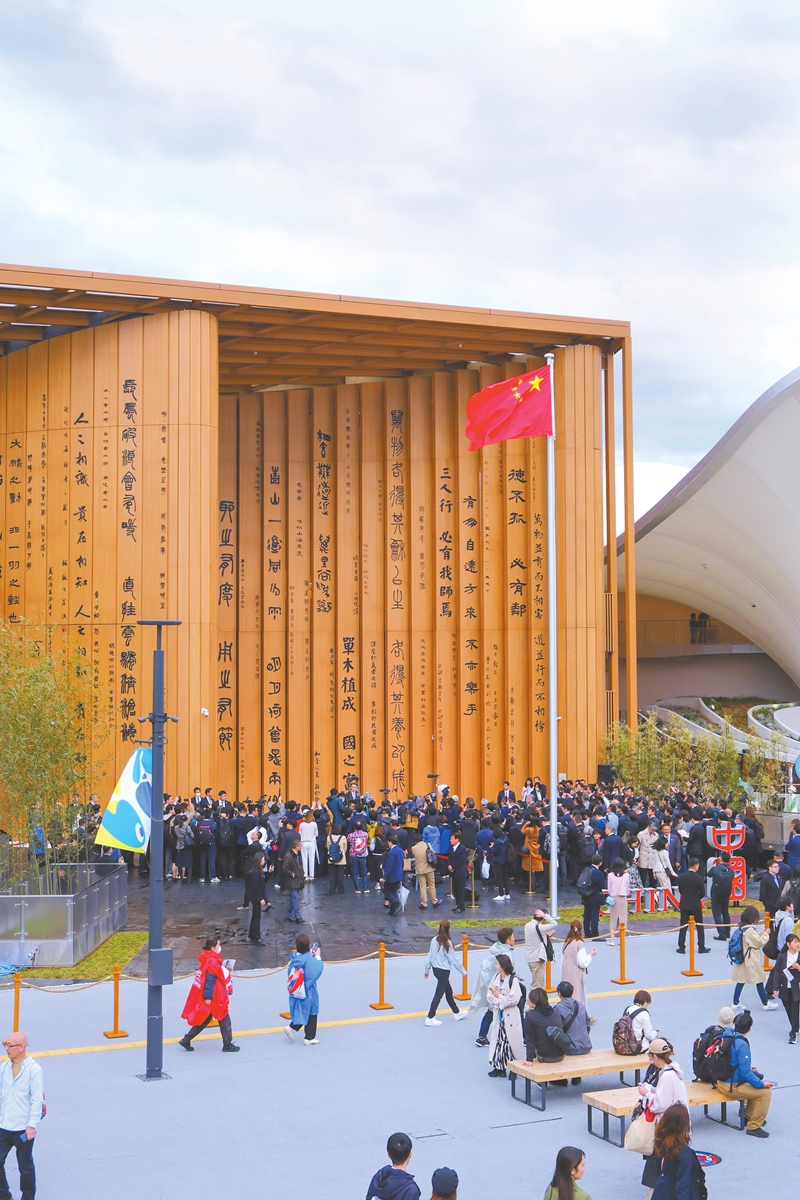
Lunar soil samples collected by China's Chang'e-5 and Chang'e-6 missions from the moon displayed at the China Pavilion of 2025 Osaka Expo. Photo: Courtesy of CCPIT
How would you feel when standing in front of an ancient scroll-inspired building while a humanoid robot walks you through a Southern Song Dynasty (1127-1279) painting? This seemingly surreal scene isn't imaginary - it became reality this Sunday, when the China Pavilion at the 2025 Osaka Expo was officially opened in Japan.
The China Pavilion is one of the largest self-built foreign pavilions at the expo. It captivates visitors not merely by its scale, but more so through its multiple culturally-nuanced exhibitions. From sky-longing Dunhuang art display to samples collected from the moon, the architectural marvel captures a 5,000-year-old history, presenting it in a modern way. Open until October this year, the China Pavilion, for local visitors like Ao, is as "an immersive jigsaw puzzle about Chinese cultures," he told the Global Times on Sunday.
'Cultural jigsaw game' Take "Tian Ren He Yi," meaning the "Harmony Between nature and human" for example. The China Pavilion includes three exhibiting sectors. For the seemingly abstract-sounding "Tian Ren He Yi" sector, visitors encounter a large-scale multimedia installation themed around the Chinese "24 Solar Terms." It is a digital artwork inspired by China's Southern Song Dynasty illustration book of
Pictures of Tilling and Weaving.
In ancient times, the book documented how people farm in accordance with seasonal changes. Now, with digital recreation, it allows visitors to see how China's agricultural development has long been intertwined with respect for nature. The display is then explained "tangibly" through the "human-nature harmony" curatorial theme "was not to sound poetic," but is based on real-life practices in China," curatorial expert Zhang Liming, told the Global Times.
Exhibits showcasing Chinese pursuits with the help of ancient cultural references are common to see at the China Pavilion. A replica of the Simuwu Ding, a bronze ritual vessel unearthed at the 3,300-year-old Yin Ruins, Central China's Henan Province, is on site showcasing the advanced metalworking productivity of ancient China. Another reproduction of the Sanxingdui Bronze Tree relics is displayed alongside, revealing that other than in agriculture practices, the "human-nature harmony" to the ancient Chinese was ritualistic; a shared belief in life.
Displayed not far from them is a printed edition of "Ganlu Zishu," a Chinese Tang Dynasty (618-907) orthography dictionary. It shows how Chinese calligraphic art has continually developed alongside socio-cultural changes throughout history.
At the Osaka Expo, the element of Chinese calligraphy shines not only inside the display cabinet, but also in the China Pavilion building's exterior design. Inspired by the bamboo scroll - an ancient Chinese writing medium - the façade of the China Pavilion features 119 engraved excerpts from Chinese literature and renowned poems. These texts are rendered in multiple calligraphic styles including Seal, Clerical, and Regular Scripts.
"These different cultural elements may seem scattered everywhere, but each of them is a typical example showing the continuity of the inventive spirit in Chinese culture," Zhang the expert, told the Global Times, explaining that the displayed bronze wares are examples showing the "industrial, artistic, and manufacturing creativities of ancient China."
At the China Pavilion's opening ceremony, Chinese Ambassador to Japan Wu Jianghao said that he hopes that visitors would gain insights "into China's 5,000-year civilization and its dynamic modernization" through the pavilion experience.
Dynamic experience As the ambassador has noted, the China Pavilion boasts not just classic cultural elements, but also displays the country's modern growth - mainly at living sustainability and tech-infused innovation.
At the pavilion's other exhibit themed "clear waters and lush mountains," several ecology-focused cases were introduced. In Xiamen, East China's Fujian Province, egrets returned home after the restoration of their habitat. Tongluo Moutain, a once abandoned mining area in Chongqing Municipality is one of more than 50 similar projects in China with a restored natural landscape. The Shibadong village in Central China's Hunan Province started to see gains in its tourism sector after its rural landscape was recovered.
Such cases, on the one hand, lend well to the expo's main theme of "Designing Future Society for Our Lives," on the other hand, they can "improve exchanging experiences between China and Japan," Zhou Yongsheng, a deputy director of the Japanese Studies Center at the China Foreign Affairs University, told the Global Times.
"Despite the differences, China and Japan both share commitments in similar fields such as environmental conservation and tech innovations," Zhou emphasized, adding that highlighting these topics at the China Pavilion can "better resonate with local visitors."
For visitors like Ao, what he looks forward to the most at the China Pavilion is its third exhibit titled "Shengsheng Buxi," also meaning the "continuous circle of being." It features China's advanced innovations and discoveries, in which lunar soil samples that were collected by China's Chang'e-5 and Chang'e-6 missions from moon are on display.
Preserved in two crystal balls, the lunar soil samples not only reveal to visitors the basalt material approximately 2 billion years old, but also denotes the "Chinese space industry's developments and its embrace of global operations," said Li Qingshuang, a deputy head of the China Council for the Promotion of International Trade, at a press conference on April 2. The CCPIT is the lead organizer of the China Pavilion.
Aside from the exhibition of such true "rocket science," other Chinese inventions like humanoid robots and an AI-technology inspired virtual guide "Wukong," also known as Monkey King, are on display. Unlike how it was depicted in ancient texts, the "Wukong" of the digital age speaks Chinese, Japanese, and English; another traditional culture derived icon bonding people by breaking cultural barriers.
"At the 2025 Osaka Expo, visitors from around the world will experience China's profound cultural heritage and ancient wisdom, while witnessing the nation's cutting-edge scientific innovations and creative solutions," said Secretary General of the Bureau International des Expositions Dimitri Kerkentzes at the opening ceremony of China Pavilion on Sunday.

Visitors gather at the China Pavilion of the 2025 Osaka Expo. Photo: Courtesy of CCPIT





